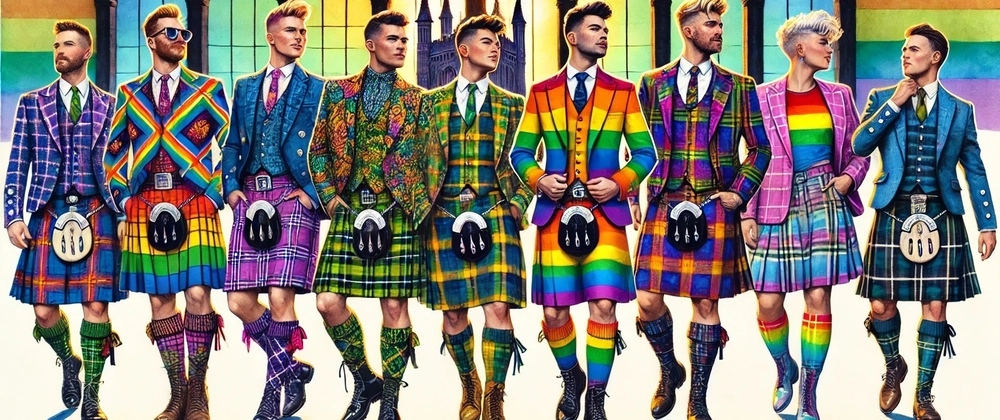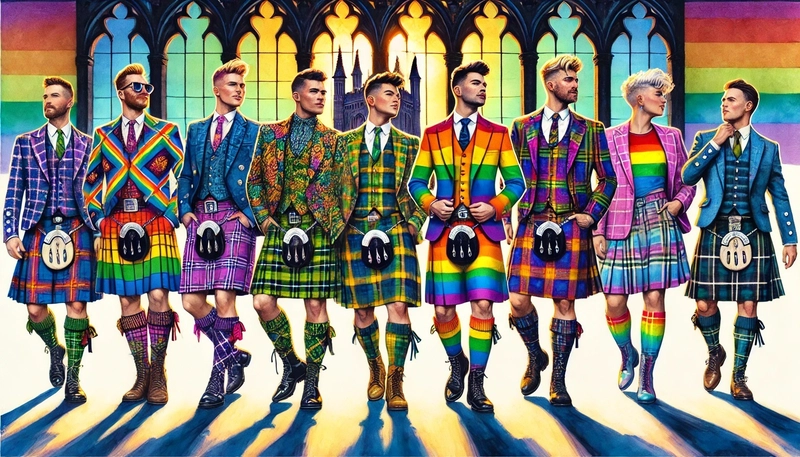Queer Tartan is more than a fashion statement—it’s a bold act of reclamation. By reimagining traditional clan patterns with queer symbolism, color, and narrative, LGBTQ+ individuals are **transforming tartan from an emblem of ancestry into a banner of chosen identity, fluid heritage, and unapologetic pride.
Introduction: Pride in Every Plaid
Tartan has long been worn to show where you come from—your family, your region, your roots. But for many queer people, the past isn’t always a place of safety or recognition. Instead of abandoning the symbols that once excluded them, LGBTQ+ communities around the world are doing something even more radical: reclaiming tartan. They’re queering it, customizing it, and transforming it into a living fabric of chosen family, intersectional pride, and personal freedom.
This is the story of Queer Tartan—not a single pattern, but a global movement to stitch queerness into heritage and wear visibility with power.
1. The Traditional Tartan & Its Limits
1.1 Symbols of Belonging (and Exclusion)
Historically, tartans represented clans and bloodlines, with registered patterns passed down through generations. But for many queer people, that kind of inherited identity can feel like a locked door:
- Families who reject LGBTQ+ identities
- Cultures where queerness is silenced
- Lineages that don’t make space for chosen family or fluid identities
For some, wearing a traditional tartan feels like stepping into history that didn’t welcome them.
💬 Queer Highlander:
"I love where I’m from. But my clan name never included me—so I made a tartan that finally does."
2. The Rise of Queer Tartan
2.1 New Patterns, New Pride
Queer Tartan designs are colorful, symbolic reinterpretations of the traditional form, created to reflect:
- LGBTQ+ flags (Rainbow, Trans, Nonbinary, Progress Pride, etc.)
- Personal stories of coming out, resistance, and joy
- The unique intersections of queerness with race, faith, gender, or migration
Instead of looking backward for meaning, these tartans look inward and forward—claiming space through creativity, not ancestry.
2.2 The Progress Pride Tartan & Beyond
Some Queer Tartans are designed to echo the structure of historical patterns, using:
- Bold stripes to represent communities
- Interwoven colors for unity and inclusion
- Gradients and fades to symbolize transition, fluidity, and spectrum
Others are completely abstract, breaking away from traditional tartan geometry to celebrate queer disruption and nonconformity.
3. Wearing Queer Tartan: More Than Fabric
3.1 Visibility with Legacy
Wearing Queer Tartan isn’t just about style—it’s about standing visibly in the space where tradition and transformation meet.
✔ At Pride marches
✔ In queer Highland games and drag events
✔ At queer weddings, naming ceremonies, and family rituals
✔ As daily wear—subtle or bold
3.2 Genderless, Formless, Fierce
Kilts, skirts, wraps, and pants made from Queer Tartan defy gender norms. The fabric itself becomes a gender-fluid landscape—pleated, draped, pinned, or flowing however the wearer desires.
💬 Nonbinary Designer:
"I made a tartan where the lines don’t match up. That’s the point. I’ve never fit a grid—and now I wear one on my own terms."
4. Chosen Families, Chosen Fabrics
4.1 Clan of Identity, Not Biology
Queer people often build families of choice—friendships and communities that offer the love and recognition their birth families couldn’t. Queer Tartan celebrates that by:
- Creating tartan sets for chosen families
- Holding naming ceremonies or “queer clan gatherings”
- Designing matching kilts for collectives, bands, ballroom houses, or friend groups
In this context, tartan becomes a mark of unity and mutual protection, not biology.
4.2 Memorial and Resistance Wear
Queer Tartans have also become part of memorial practices—honoring lost friends, victims of violence, and elders lost to AIDS and injustice. Stripes can represent names, dates, or causes.
Some wearers include embroidered protest slogans or initials stitched into pleats—turning tartan into a walking protest flag.
5. From Runways to Riots: Queer Tartan in the World
5.1 Fashion & Art Movements
Designers and visual artists are using Queer Tartan in:
- Runway collections that explore identity and belonging
- Sculptural garments in queer gallery installations
- Textile activism projects that reimagine national flags or historical dress
5.2 Global Influence & Cultural Fusion
Queer Tartans are being fused with:
- African wax prints
- South Asian embroidery
- Indigenous regalia
- Latin American protestwear
This global remix reflects the intersectional and expansive nature of the queer experience.
💬 Artist’s Note:
"I don’t wear my grandmother’s tartan—I wear one inspired by her courage."
6. How to Create Your Own Queer Tartan
✔ Choose a color palette that reflects your truth—your flag, your story, your vibe
✔ Design your tartan digitally or by hand, assigning meaning to each stripe
✔ Work with queer designers or inclusive weavers who respect the vision
✔ Add personalized elements:
– Stitch in your name or chosen pronouns
– Include quotes, lyrics, or dates
– Incorporate old clothing or materials from queer community events
💬 DIY Creator:
"Mine’s made from Pride flags, drag curtain scraps, and the shirt I came out in."
Conclusion: Legacy Isn’t Given—It’s Made
Queer Tartan is more than a remix—it’s a reclamation. It takes the threads of ancestry and reweaves them with intention, imagination, and unapologetic pride. In a world where tradition often erases queer people, Queer Tartan shouts:
“We’re still here. And we belong in the fabric of history.”
Because sometimes, what you wear is who you are—and sometimes, it’s who you dared to become.
Tags:
queer tartan, LGBTQ+ kilts, chosen family fashion, modern tartan design, genderfluid clothing, queer heritage, pride tartan, inclusive kilts, nonbinary fashion, cultural reclamation, identity textiles, wearable protest, queer ancestry fashion, pride fashion trends, queer symbolism in tartan, tartan reinvention, pride in plaid, custom tartan, queer fashion history, kilts for chosen families






Top comments (0)